Past Exhibition
Something Worth Doing
Amber Eve Anderson’s solo exhibition Something Worth Doing is a playful reflection on the objects with which we surround ourselves, and the comforts they provide, both physically and psychologically.…
Why do we buy certain things? Why do we save certain things? Amber Eve Anderson asked me these questions during our first conversation, leading us to further inquiries about commodity logistics and how we ascribe value to objects once we acquire them. We considered, for example, the back massager that she purchased via the (sometimes annoyingly accurate) targeted advertisements on her feed, and the comfort the massager has given her—so much so that she gifted it to a family member. Although Anderson’s questions were in large part rhetorical, I thought perhaps the answer is, “Because objects can connect us to the world and to ourselves.”
In her book Evocative Objects (2007), sociologist–psychologist Sherry Turkle reminds us how we’re well-rehearsed to consider objects as “useful or aesthetic, as necessities or vain indulgences,” but less so when we consider them as “companions to our emotional lives or as provocations to thought.”¹ Anderson’s solo exhibition Something Worth Doing (2022)—on view at Hamiltonian Artists from May 21 to July 11, 2022—asks the previously mentioned questions, and complicates them by exhibiting how objects are connected through a web of economic and personal relations.

When entering the exhibition, Anderson presents the audience with a monoprint titled Amazon (2022). The coarse gray pattern of the print is obscure, but upon further inspection, fragments of corrugated fiberboard remain adhered to the surface. One can glean that the instrument used to transfer the ink was a cardboard box. According to the price list, the work is available for precisely $286.34, representing the total amount that she spent on Amazon deliveries from January through April 2022. Further down the room are additional monograph prints—each titled with their corresponding suppliers produced with the delivered packaging.
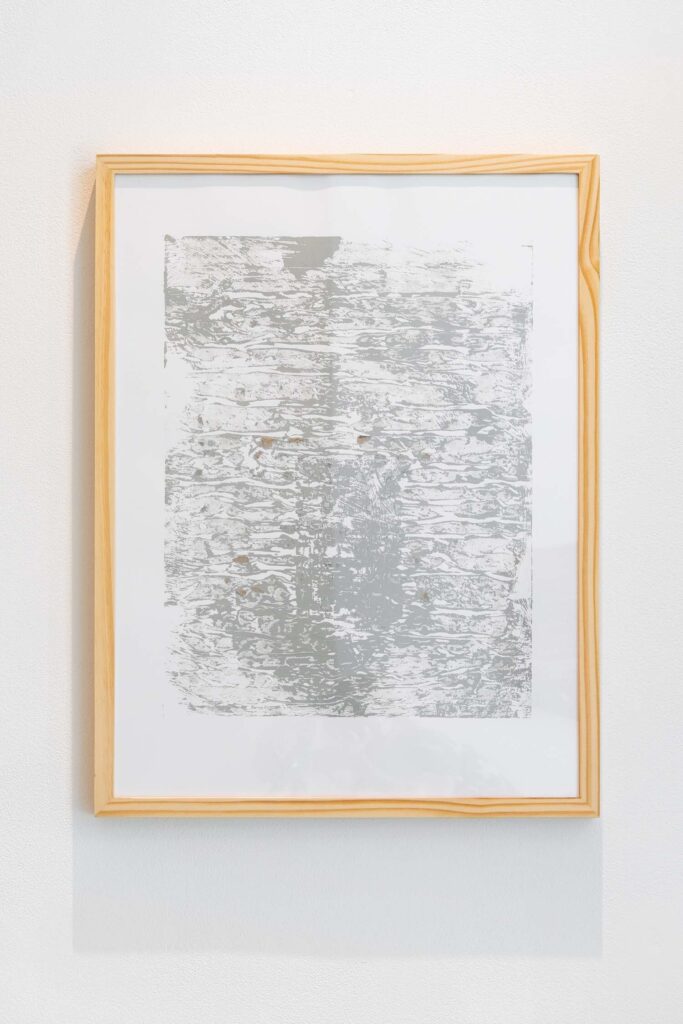
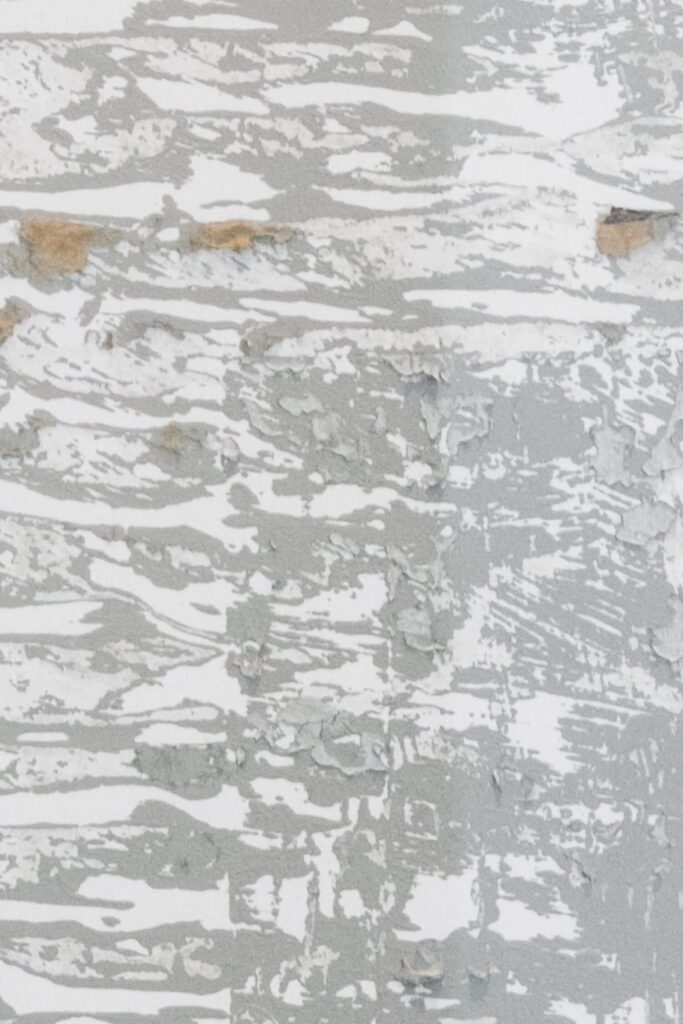
In dialogue with the prints are two photograph collages—titled Ordered (2022) and Fulfilled (2022)—with which they examine delivery operations and their surveilling properties. Using photos taken solely by Amazon, the collages exhibit an array of perspectives of Anderson’s front doorstep. Amazon takes confirmation photos of the packages for the customers and the company’s assurance.² I was surprised to learn that this policy only began in May 2018 and that I have already normalized this practice.
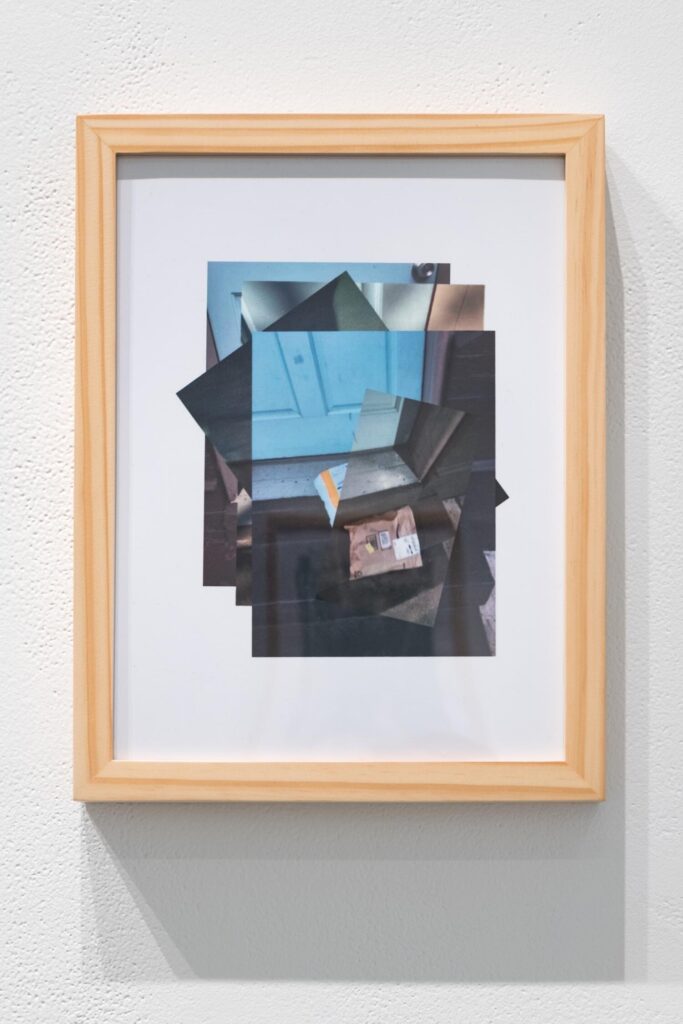
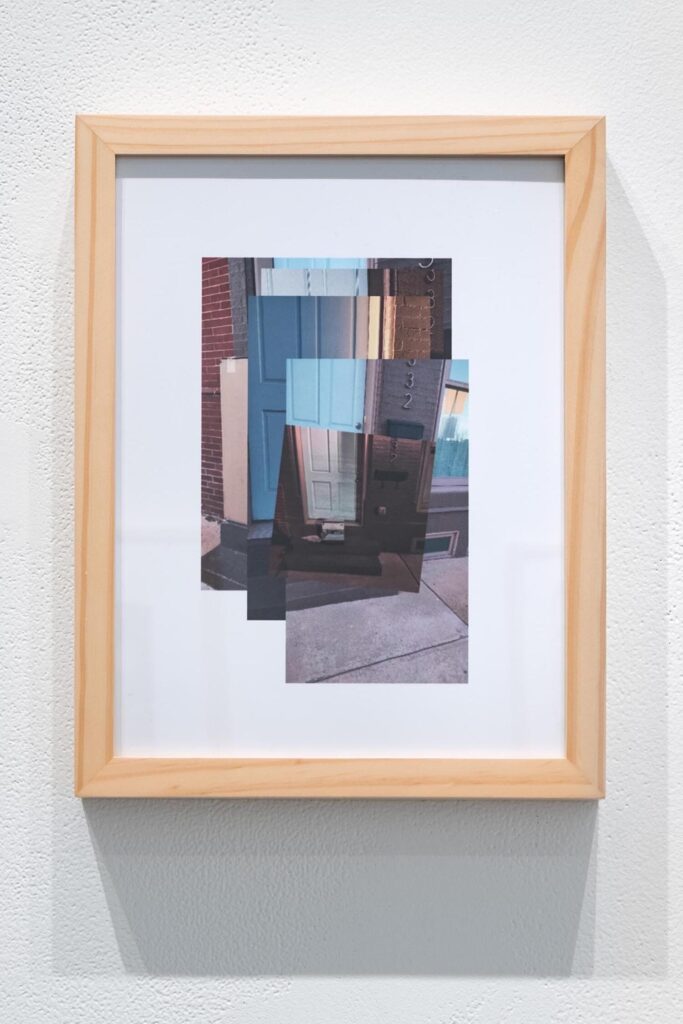
This series of multimedia artworks picks up on several themes from Anderson’s previous exhibition titled This Is Who I Am Now (2020)—her first solo exhibition with Hamiltonian Artists. She had displayed an archive of every Instagram ad presented to her over the course of one week. Building such an archive, according to Anderson, is “a way to combat the speed of digital life” and “visualize what I’m experiencing but not necessarily consciously.”³ The show’s title posits that she is the algorithm that she feeds with her “likes” and purchases. In response to a study on how platforms and algorithms “understand” us, demonstrating how 68 Facebook likes could predict one’s race, sexuality, and politics,⁴ technology scholar Ramesh Srinivasan states the following:
It’s troubling that these models define terms like “sexuality,” “intelligence,” and “behavior” in extremely reductive ways. In doing so they relegate the manner in which we define of the most complex parts of life to the binary, yes-or-no logic of labels. Even worse, they do this in ways that are hidden from us.⁵
To what extent is the algorithm’s hidden translation of us at odds with how we see ourselves? How do these exchanges on the screen—from “like” to purchase—continue to shape our behavior? These questions carry over into the exhibition Something Worth Doing.
As demonstrated in her Instagram and Amazon archive, Anderson’s archival method borders mindfulness and self-surveillance to highlight the platforms’ surveilling properties. This act of turning the gaze back toward corporate power is perhaps a type of “sousveillance,” a term coined by Steve Mann.⁶ Literally translating to “seeing from below,” this tactic is typically deployed as a form of resistance, whereby the observed documents the observer (for example, self-recording the police). Anderson’s archival method might be best described as platform sousveillance, co-opting captured data to observe the platform. How Anderson uses a market apparatus to look back at networking services and, in turn, herself continues to be a theme in her work.
Displayed in the center of the room are sculptures that reassemble and repurpose objects owned by the artist. The series of four sculptures consist of mostly-household items on foam mattress tops of different colors. For example, in If Only It Were Scented (2022), set on top of purple padding, includes objects such as painted sticks, a candle, a braid of sweetgrass, a photograph, a clock, a white glove, and a wrapping paper with pine needles. As mentioned in the press release, these mattress tops (or “rafts” as they’re referred to colloquially among exhibition staff) could be read as a metaphor for relying on such products for comfort.
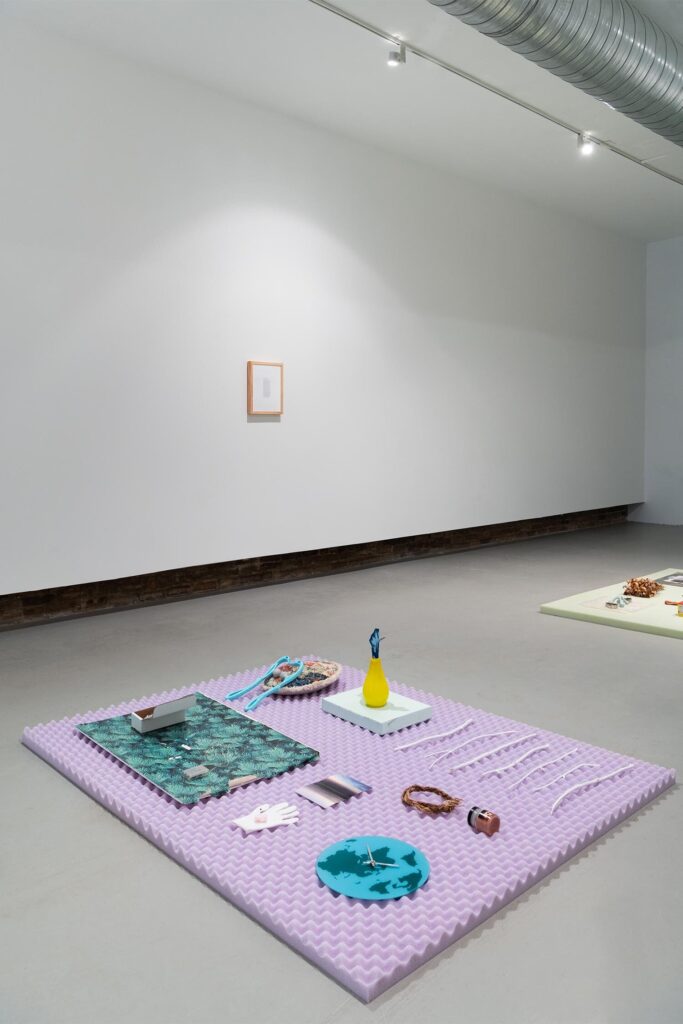
In her previous exhibition, This Is Who I Am Now, Anderson decided to separate commodities targeted to her, from sentimental objects that are not for purchase. The archive-as-artwork Demographic Case Study (35–44, Woman, Baltimore) (2020) consisted of printed Instagram ads at a 1:1 scale, installed on pedestal sculptures in the center of the space. This was contrasted with the series on the wall Accumulations (2020), which included found objects and photographs that were not for sale. (An example of such repurposed items is the back of her grandmother’s photo with her handwriting.)
There is no hesitation now in combining objects with sentimentality from childhood memories, with cheap comfort from an Instagram-ad purchase. Anderson makes no distinction between objects with personal relationships, and objects acquired through an algorithm. Still, the sculptures could be read as a self-portrait vis-à-vis her personal objects.
In Something Worth Doing, a new thread runs through her sculptures: the notion of gifts, with several sculptures containing items such as wrapping paper or a bow. Returning to Turkle’s evocative objects, she notes that gifts can retain something of their givers. As she thinks through Marx’s definition of commodities and the work of social theorist Marcel Mauss, Turkle states how “[a] gift carries an economic and relational web; the object is animated by the network within it.”⁷

Anderson gives several objects presented in the show a “review.” The reviews are written in the form of an Amazon review and framed throughout the gallery space, rating various mundane objects from her life, based on a metric of her own invention. Pine tree wrapping paper, for example, receives five-out-of-five stars for the memories it conjures of the pine trees in her childhood backyard. Cottonwood seeds, objects that cannot be purchased, also receive five stars for their similar ability to invoke recollections of Anderson’s past. The four sets of milk glasses, arguably the most sentimental objects to her since she obtained them from her grandmother, received the lowest rating. These objects were marked down because of how outdated and useless they felt to Anderson.
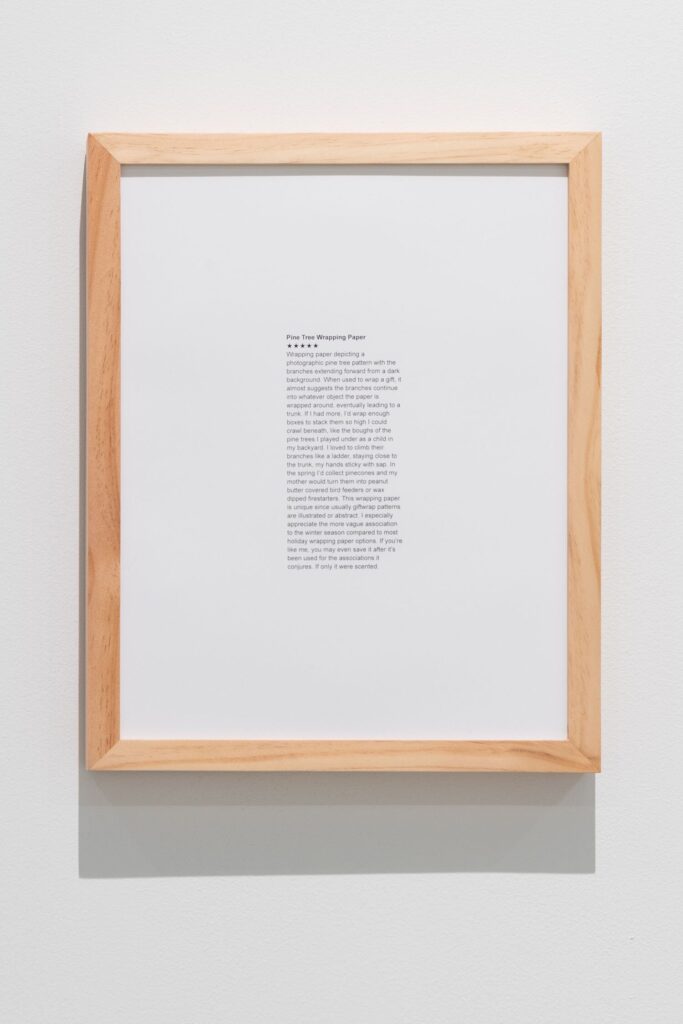
Since Anderson adds to the conversation from her last exhibition, I believe there is significance in the transition between her titles, from This Is Who I Am Now to Something Worth Doing. Perhaps this transition disturbs the idea of an “authentic self” among our web of relations. Or maybe we relate more to others and ourselves through gift exchange, rather than commodity exchange. Or, that the order and value we give the things around us begin to shape us in return—a process that is always in flux. Trying to make a conclusion about our web of relations, through this lens of artistic production, only leads to further self-reflective questions, which is, I think, something worth doing.
Mark Anthony Hernández Motaghy is an artist, researcher, and community organizer.
1. Sherry Turkle, Evocative Objects: Things We Think With (The MIT Press, 2007), p. 5
2. “Amazon Photo on Delivery,” Amazon (Accessed 26 June 2022)
3. “Artist Talk: Amber Eve Anderson & Madeline a Stratton,” Hamiltonian Artists (14 November 2020)
4. See Michal Kosinski, David Stillwell, and Thore Graepel, “Private Traits and Attributes Are Predictable from Digital Records of Human Behavior,” Proceedings of the National Academy of Sciences 110, no. 15 (2013)
5. Ramesh Srinivasan, Beyond the Valley: How Innovators around the World are Overcoming Inequality and Creating the Technologies of Tomorrow, (The MIT Press, 2019), p. 41
6. See Steve Mann’s “Sousveillance: Inventing and Using Wearable Computing Devices for Data Collection in Surveillance Environments” (1 September 2002)
7. Sherry Turkle, Evocative Objects, p. 312
Past Exhibition
Amber Eve Anderson’s solo exhibition Something Worth Doing is a playful reflection on the objects with which we surround ourselves, and the comforts they provide, both physically and psychologically.…